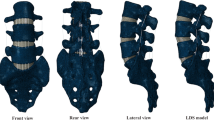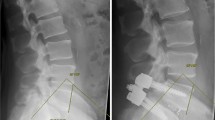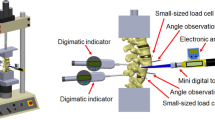Abstract
The clinical advantages of reducing spondylolisthesis over fusion in situ have several intuitive reasons such as restore the spinal column into a more anatomic relationship and alignment. However, there is only little evidence in the literature supporting the theoretical advantages of reduction, and its effect on spinopelvic alignment remains poorly defined. In this study, a comprehensive finite element model was developed to analyze the biomechanics of the spine after spinal fusion at L5–S1 in both types of high-grade spondylolisthesis (balanced and unbalanced pelvis). The relevant clinical indices (i.e. spondylolisthesis grade and Dubousset lumbosacral angle), the displacement of L4–L5, pressure within the annulus and nucleus, and stress at L4–L5 were evaluated and compared. The model can well predict the changes of the important clinical indices during the surgery. For a balanced pelvis, the reduction has a minimal effect on the biomechanical conditions at the adjacent level during postsurgical activities. In the unbalanced case, reduction induced larger deformation in the lumbosacral region and a higher stress concentration at adjacent level. Whether such a stress concentration can lead to long-term disc degeneration is not known. The results provide additional information for the clinician considering reduction of high-grade spondylolisthesis.






Similar content being viewed by others
References
Aubin CE, Dansereau J, Parent F, Labelle H, de Guise JA (1997) Morphometric evaluations of personalised 3D reconstructions and geometric models of the human spine. Med Biol Eng Comput 35:611–618
Bradford DS (1979) Treatment of severe spondylolisthesis: a combined approach for reduction and stabilization. Spine 4:423–429
Bradford DS, Boachie-Adjei O (1990) Treatment of severe spondylolisthesis by anterior and posterior reduction and stabilization. A long-term follow-up study. J Bone Joint Surg 72:1060–1066
Breau C, Shirazi-Adl A, de Guise J (1991) Reconstruction of a human ligamentous lumbar spine using CT images—a three-dimensional finite element mesh generation. Ann Biomed Eng 19:291–302
Chen C-S, Cheng C-K, Liu C-L, Lo W-H (2001) Stress analysis of the disc adjacent to interbody fusion in lumbar spine. Med Eng Phys 23:485–493
Chosa E, Totoribe K, Tajima N (2004) A biomechanical study of lumbar spondylolysis based on a three-dimensional finite element method. J Orthop Res 22:158–163
Delorme S, Petit Y, de Guise JA, Labelle H, Aubin CE, Dansereau J (2003) Assessment of the 3-D reconstruction and high-resolution geometrical modeling of the human skeletal trunk from 2-D radiographic images. IEEE Trans Biomed Eng 50:989–998
El-Rich M, Villemure I, Labelle H, Aubin CE (2009) Mechanical loading effects on isthmic spondylolytic lumbar segment: finite element modelling using a personalised geometry. Comput Methods Biomech Biomed Eng 12:13–23
El-Rich M, Arnoux P-J, Wagnac E, Brunet C, Aubin CE (2009) Finite element investigation of the loading rate effect on the spinal load-sharing changes under impact conditions. J Biomech 42:1252–1262
Guan Y, Yoganandan N, Moore J, Pintar FA, Zhang J, Maiman DJ, Laud P (2007) Moment-rotation responses of the human lumbosacral spinal column. J Biomech 40:1975–1980
Hensinger RN (1989) Spondylolysis and spondylolisthesis in children and adolescents. J Bone Joint Surg Am 71:1098
Hresko MT, Labelle H, Roussouly P, Berthonnaud E (2007) Classification of high-grade spondylolistheses based on pelvic version and spine balance: possible rationale for reduction. Spine 32:2208–2213
Humbert L, de Guise JA, Aubert B, Godbout B, Skalli W (2009) 3D reconstruction of the spine from biplanar X-rays using parametric models based on transversal and longitudinal inferences. Med Eng Phys 31:681–687
Kasliwal MK, Smith JS, Shaffrey CI, Saulle D, Lenke LG, Polly DW Jr, Ames CP, Perra JH (2012) Short-term complications associated with surgery for high-grade spondylolisthesis in adults and pediatric patients: a report from the scoliosis research society morbidity and mortality database. Neurosurgery 71:109–116
Konz RJ, Goel VK, Grobler LJ, Grosland NM, Spratt KF, Scifert JL, Sairyo K (2001) The pathomechanism of spondylolytic spondylolisthesis in immature primate lumbar spines: in vitro and finite element assessments. Spine 26:E38–E49
Kumar M, Baklanov A, Chopin D (2001) Correlation between sagittal plane changes and adjacent segment degeneration following lumbar spine fusion. Eur Spine J 10:314–319
Labelle H, Mac-Thiong JM (2011) Pre and post-operative assessment of sagittal balance for high-grade developmental spondylolisthesis. ArgoSpine News J 23:28–32
Labelle H, Roussouly P, Berthonnaud E, Transfeldt E, O’Brien M, Chopin D, Hresko T, Dimnet J (2004) Spondylolisthesis, pelvic incidence, and spinopelvic balance: a correlation study. Spine 29:2049–2054
Labelle H, Roussouly P, Chopin D, Berthonnaud E, Hresko T, O’Brien M (2008) Spino-pelvic alignment after surgical correction for developmental spondylolisthesis. Eur Spine J 17:1170–1176
Mac-Thiong JM, Labelle H (2006) A proposal for a surgical classification of pediatric lumbosacral spondylolisthesis based on current literature. Eur Spine J 15:1425–1435
Mardjetko S, Albert T, Andersson G, Bridwell K, DeWald C, Gaines R, Geck M, Hammerberg K, Herkowitz H, Kwon B (2005) Spine/SRS spondylolisthesis summary statement. Spine 30:S3
Martiniani M, Lamartina C, Specchia N (2012) “in situ” fusion or reduction in high-grade high dysplastic developmental spondylolisthesis (HDSS). Eur Spine J 21:134–140
Meyerding HW (1931) Spondylolisthesis. J Bone Joint Surg 13:39–48
Muschik M, Zippel H, Perka C (1997) Surgical management of severe spondylolisthesis in children and adolescents: anterior fusion in situ versus anterior spondylodesis with posterior transpedicular instrumentation and reduction. Spine 22:2036–2042
Natarajan RN, Garretson Iii RB, Biyani A, Lim TH, Andersson GBJ, An HS (2003) Effects of slip severity and loading directions on the stability of isthmic spondylolisthesis: a finite element model study. Spine 28:1103–1112
O’Brien JP, Mehdian H, Jaffray D (1994) Reduction of severe lumbosacral spondylolisthesis. A report of 22 cases with a ten-year follow-up period. Clin Orthop Relat Res 300:64–69
Osterman K, Schlenzka D, Poussa M, Seitsalo S, Virta L (1993) Isthmic spondylolisthesis in symptomatic and asymptomatic subjects, epidemiology, and natural history with special reference to disk abnormality and mode of treatment. Clin Orthop Relat Res 297:65–70
Park P, Garton HJ, Gala VC, Hoff JT, McGillicuddy JE (2004) Adjacent segment disease after lumbar or lumbosacral fusion: review of the literature. Spine 29:1938–1944
Poussa M, Schlenzka D, Seitsalo S, Ylikoski M, Hurri H, Osterman K (1993) Surgical treatment of severe isthmic spondylolisthesis in adolescents: reduction or fusion in situ. Spine 18:894–901
Roussouly P, Meyrat RB (2011) High-grade spondylolisthesis: partial reduction. In: Bridwell K, DeWald R (eds) Textbook of spinal surgery. Lippincott Williams & Wilkins, Philadelphia, p 638
Sairyo K, Goel VK, Grobler LJ, Ikata T, Katoh S (1998) The pathomechanism of isthmic lumbar spondylolisthesis: a biomechanical study in immature calf spines. Spine 23:1442–1446
Sairyo K, Katoh S, Ikata T, Fujii K, Kajiura K, Goel VK (2001) Development of spondylolytic olisthesis in adolescents. Spine J 1:171–175
Sairyo K, Goel VK, Masuda A, Vishnubhotla S, Faizan A, Biyani A, Ebraheim N, Yonekura D, Murakami R-I, Terai T (2006) Three dimensional finite element analysis of the pediatric lumbar spine. Part II: biomechanical change as the initiating factor for pediatric isthmic spondylolisthesis at the growth plate. Eur Spine J 15:930–935
Schmidt H, Kettler A, Heuer F, Simon U, Claes L, Wilke H-J (2007) Intradiscal pressure, shear strain, and fiber strain in the intervertebral disc under combined loading. Spine 32:748–755
Sevrain A, Aubin C-E, Gharbi H, Wang X, Labelle H (2012) Biomechanical evaluation of predictive parameters of progression in adolescent isthmic spondylolisthesis: a computer modeling and simulation study. Scoliosis 7:1–9
Shirazi-Adl A (2006) Analysis of large compression loads on lumbar spine in flexion and in torsion using a novel wrapping element. J Biomech 39:267–275
Wagnac E, Arnoux P-J, As Garo, El-Rich M, Aubin CE (2011) Calibration of hyperelastic material properties of the human lumbar intervertebral disc under fast dynamic compressive loads. J Biomech Eng 133:101007
Yamamoto S, Tanaka E, Mihara K, Inoue H, Ohmori K (1999) Finite element evaluation of spondylolysis taking account of nonlinear mechanical properties of ligaments and annulus fibrosus. JSME Int J, Ser C 42:521–531
Acknowledgments
This study was funded by the Natural Sciences and Engineering Research Council of Canada (Industrial Research Chair program with Medtronic of Canada) and a research scholarship from Shriners Hospitals for Children.
Author information
Authors and Affiliations
Corresponding author
Rights and permissions
About this article
Cite this article
Wang, W., Aubin, CE., Cahill, P. et al. Biomechanics of high-grade spondylolisthesis with and without reduction. Med Biol Eng Comput 54, 619–628 (2016). https://doi.org/10.1007/s11517-015-1353-0
Received:
Accepted:
Published:
Issue Date:
DOI: https://doi.org/10.1007/s11517-015-1353-0




